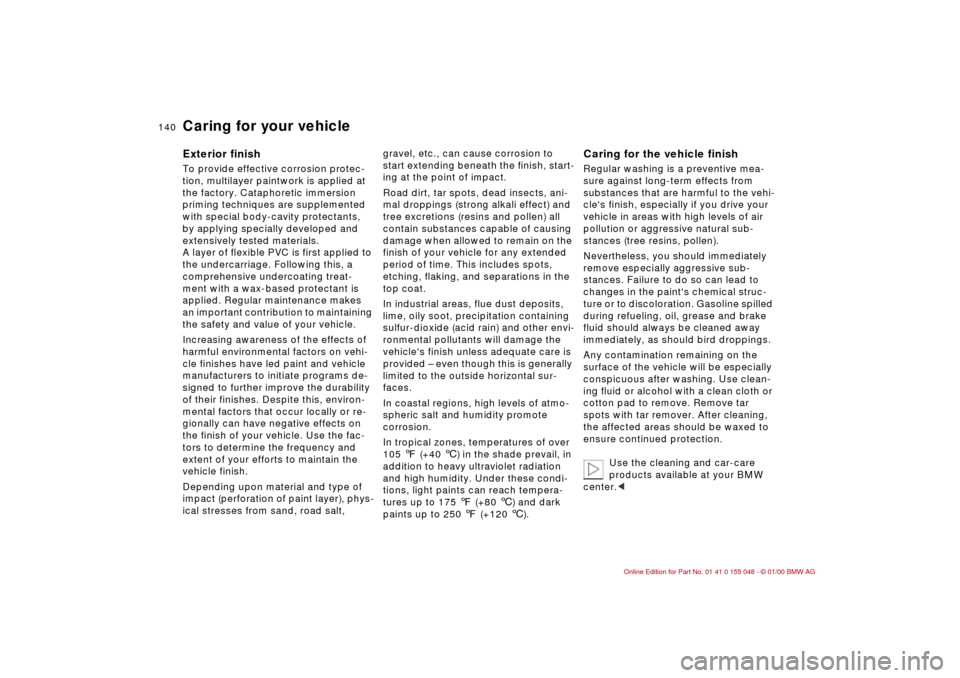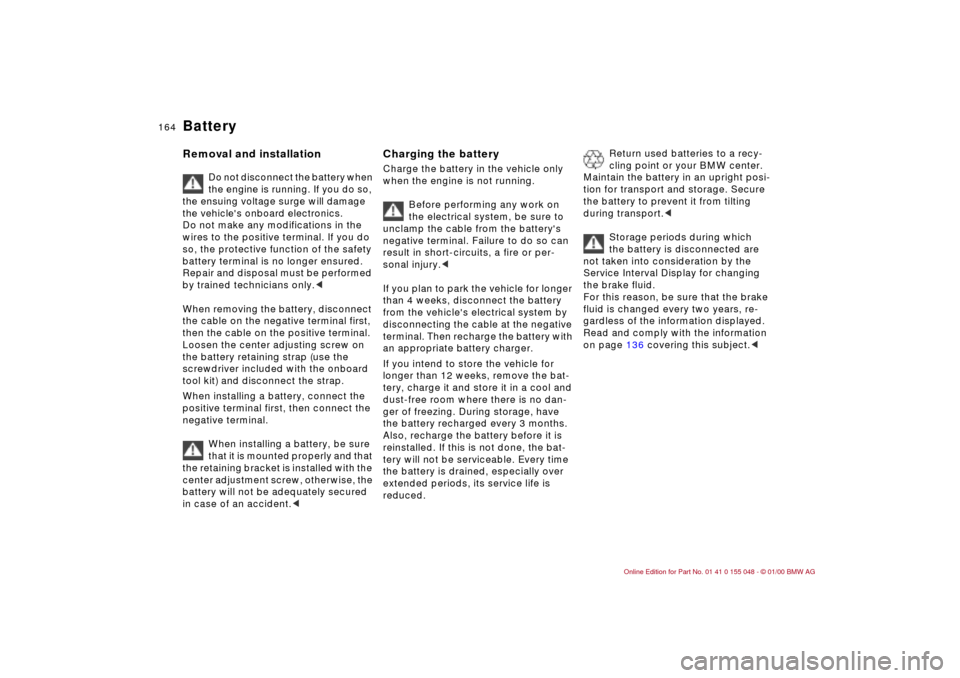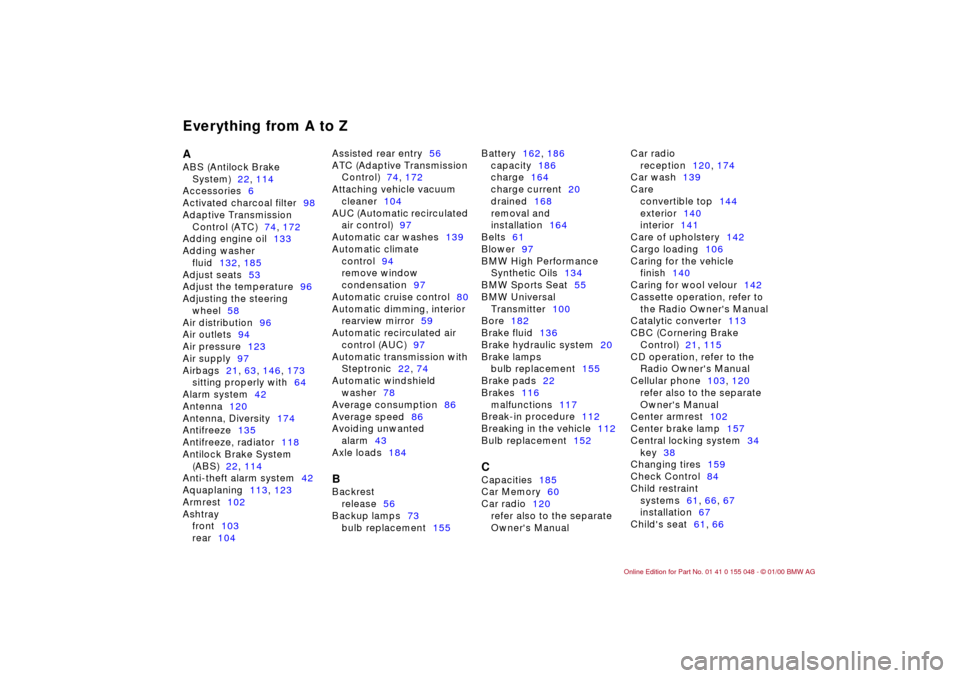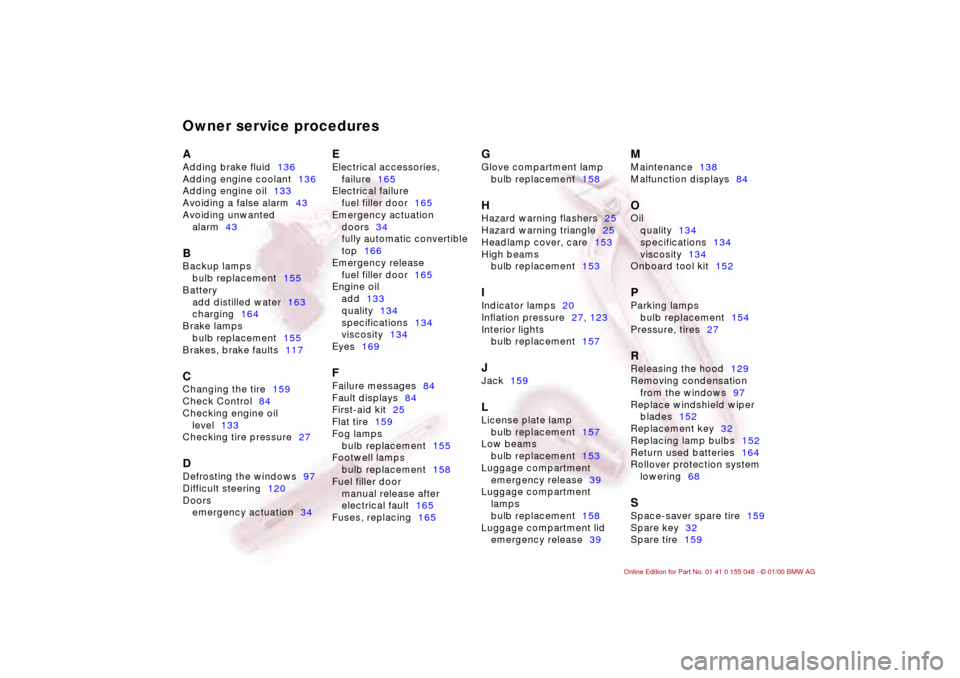2000 BMW 323Ci CONVERTIBLE brake fluid
[x] Cancel search: brake fluidPage 140 of 199

140n
Caring for your vehicleExterior finish To provide effective corrosion protec-
tion, multilayer paintwork is applied at
the factory. Cataphoretic immersion
priming techniques are supplemented
with special body-cavity protectants,
by applying specially developed and
extensively tested materials.
A layer of flexible PVC is first applied to
the undercarriage. Following this, a
comprehensive undercoating treat-
ment with a wax-based protectant is
applied. Regular maintenance makes
an important contribution to maintaining
the safety and value of your vehicle.
Increasing awareness of the effects of
harmful environmental factors on vehi-
cle finishes have led paint and vehicle
manufacturers to initiate programs de-
signed to further improve the durability
of their finishes. Despite this, environ-
mental factors that occur locally or re-
gionally can have negative effects on
the finish of your vehicle. Use the fac-
tors to determine the frequency and
extent of your efforts to maintain the
vehicle finish.
Depending upon material and type of
impact (perforation of paint layer), phys-
ical stresses from sand, road salt, gravel, etc., can cause corrosion to
start extending beneath the finish, start-
ing at the point of impact.
Road dirt, tar spots, dead insects, ani-
mal droppings (strong alkali effect) and
tree excretions (resins and pollen) all
contain substances capable of causing
damage when allowed to remain on the
finish of your vehicle for any extended
period of time. This includes spots,
etching, flaking, and separations in the
top coat.
In industrial areas, flue dust deposits,
lime, oily soot, precipitation containing
sulfur-dioxide (acid rain) and other envi-
ronmental pollutants will damage the
vehicle's finish unless adequate care is
provided – even though this is generally
limited to the outside horizontal sur-
faces.
In coastal regions, high levels of atmo-
spheric salt and humidity promote
corrosion.
In tropical zones, temperatures of over
105 7 (+40 6) in the shade prevail, in
addition to heavy ultraviolet radiation
and high humidity. Under these condi-
tions, light paints can reach tempera-
tures up to 175 7 (+80 6) and dark
paints up to 250 7 (+120 6).
Caring for the vehicle finish Regular washing is a preventive mea-
sure against long-term effects from
substances that are harmful to the vehi-
cle's finish, especially if you drive your
vehicle in areas with high levels of air
pollution or aggressive natural sub-
stances (tree resins, pollen).
Nevertheless, you should immediately
remove especially aggressive sub-
stances. Failure to do so can lead to
changes in the paint's chemical struc-
ture or to discoloration. Gasoline spilled
during refueling, oil, grease and brake
fluid should always be cleaned away
immediately, as should bird droppings.
Any contamination remaining on the
surface of the vehicle will be especially
conspicuous after washing. Use clean-
ing fluid or alcohol with a clean cloth or
cotton pad to remove. Remove tar
spots with tar remover. After cleaning,
the affected areas should be waxed to
ensure continued protection.
Use the cleaning and car-care
products available at your BMW
center.<
Page 147 of 199

147n
IndexDataTechnologyRepairsCar careControlsOverview
Vehicle storage
If you intend to store the vehicle
for more than three months, have
the maintenance operations described
on this page performed.<
Preparations for storageHave your BMW center perform the fol-
lowing procedures:
1 Clean and apply a rustproofing agent
or other treatment to the engine,
engine compartment, undercarriage,
axles and major components in ac-
cordance with approved repair pro-
cedures. Washing the vehicle, any in-
terior cleaning and subsequent paint-
and chrome care, and cleaning any
rubber seals for the hood and doors,
should be carried out in compliance
with approved procedures as well
2 Change engine oil and oil filter at op-
erating temperature. As an additional
corrosion protection measure, an an-
ticorrosive agent can be added to the
engine when refueling in accordance
with the manufacturer's instructions
3 Check the coolant level and concen-
tration and top off if necessary
4 Fill the fuel tank completely to pre-
vent the formation of condensation
5 Increase the tire inflation pressure to
51 psi (350 kPa).
Before parking the vehicle1 Dry the parking brake and footbrakes
completely to keep the brake discs
and drums from corroding
2 Park the vehicle in a covered, dry,
and well-ventilated space. Place the
transmission in first gear or set the
selector lever to the "P" position.
Chock the wheels to prevent the ve-
hicle from rolling if necessary. Do not
apply the parking brake
3 Remove the battery, charge it com-
pletely and store it in a cool (but
frost-free) room
4 Remove the hardtop
* and store it
separately. Refer to page 121
5 Close the convertible top.
During storageRecharge the battery every six months.
If it is not recharged, it will not be ser-
viceable. Every time the battery drains,
especially over extended periods, its
service life is reduced.
Removing the vehicle from
storageRecharge the battery if the "Magic
Eye"
* turns black. Refer to page 162.
Then have Inspection I performed by
your BMW center, including a brake
fluid replacement if necessary. Refer to
the Service and Warranty Information
Booklet (US models) or the Warranty
and Service Guide (Canadian models).
Page 164 of 199

164n
BatteryRemoval and installation
Do not disconnect the battery when
the engine is running. If you do so,
the ensuing voltage surge will damage
the vehicle's onboard electronics.
Do not make any modifications in the
wires to the positive terminal. If you do
so, the protective function of the safety
battery terminal is no longer ensured.
Repair and disposal must be performed
by trained technicians only.<
When removing the battery, disconnect
the cable on the negative terminal first,
then the cable on the positive terminal.
Loosen the center adjusting screw on
the battery retaining strap (use the
screwdriver included with the onboard
tool kit) and disconnect the strap.
When installing a battery, connect the
positive terminal first, then connect the
negative terminal.
When installing a battery, be sure
that it is mounted properly and that
the retaining bracket is installed with the
center adjustment screw, otherwise, the
battery will not be adequately secured
in case of an accident.<
Charging the battery Charge the battery in the vehicle only
when the engine is not running.
Before performing any work on
the electrical system, be sure to
unclamp the cable from the battery's
negative terminal. Failure to do so can
result in short-circuits, a fire or per-
sonal injury.<
If you plan to park the vehicle for longer
than 4 weeks, disconnect the battery
from the vehicle's electrical system by
disconnecting the cable at the negative
terminal. Then recharge the battery with
an appropriate battery charger.
If you intend to store the vehicle for
longer than 12 weeks, remove the bat-
tery, charge it and store it in a cool and
dust-free room where there is no dan-
ger of freezing. During storage, have
the battery recharged every 3 months.
Also, recharge the battery before it is
reinstalled. If this is not done, the bat-
tery will not be serviceable. Every time
the battery is drained, especially over
extended periods, its service life is
reduced.
Return used batteries to a recy-
cling point or your BMW center.
Maintain the battery in an upright posi-
tion for transport and storage. Secure
the battery to prevent it from tilting
during transport.<
Storage periods during which
the battery is disconnected are
not taken into consideration by the
Service Interval Display for changing
the brake fluid.
For this reason, be sure that the brake
fluid is changed every two years, re-
gardless of the information displayed.
Read and comply with the information
on page 136 covering this subject.<
Page 190 of 199

Everything from A to ZAABS (Antilock Brake
System)22, 114
Accessories6
Activated charcoal filter98
Adaptive Transmission
Control (ATC)74, 172
Adding engine oil133
Adding washer
fluid132, 185
Adjust seats53
Adjust the temperature96
Adjusting the steering
wheel58
Air distribution96
Air outlets94
Air pressure123
Air supply97
Airbags21, 63, 146, 173
sitting properly with64
Alarm system42
Antenna120
Antenna, Diversity174
Antifreeze135
Antifreeze, radiator118
Antilock Brake System
(ABS)22, 114
Anti-theft alarm system42
Aquaplaning113, 123
Armrest102
Ashtray
front103
rear104Assisted rear entry56
ATC (Adaptive Transmission
Control)74, 172
Attaching vehicle vacuum
cleaner104
AUC (Automatic recirculated
air control)97
Automatic car washes139
Automatic climate
control94
remove window
condensation97
Automatic cruise control80
Automatic dimming, interior
rearview mirror59
Automatic recirculated air
control (AUC)97
Automatic transmission with
Steptronic22, 74
Automatic windshield
washer78
Average consumption86
Average speed86
Avoiding unwanted
alarm43
Axle loads184
BBackrest
release56
Backup lamps73
bulb replacement155Battery162, 186
capacity186
charge164
charge current20
drained168
removal and
installation164
Belts61
Blower97
BMW High Performance
Synthetic Oils134
BMW Sports Seat55
BMW Universal
Transmitter100
Bore182
Brake fluid136
Brake hydraulic system20
Brake lamps
bulb replacement155
Brake pads22
Brakes116
malfunctions117
Break-in procedure112
Breaking in the vehicle112
Bulb replacement152
CCapacities185
Car Memory60
Car radio120
refer also to the separate
Owner's ManualCar radio
reception120, 174
Car wash139
Care
convertible top144
exterior140
interior141
Care of upholstery142
Cargo loading106
Caring for the vehicle
finish140
Caring for wool velour142
Cassette operation, refer to
the Radio Owner's Manual
Catalytic converter113
CBC (Cornering Brake
Control)21, 115
CD operation, refer to the
Radio Owner's Manual
Cellular phone103, 120
refer also to the separate
Owner's Manual
Center armrest102
Center brake lamp157
Central locking system34
key38
Changing tires159
Check Control84
Child restraint
systems61, 66, 67
installation67
Child's seat61, 66
Everything from A to Z
Page 196 of 199

Owner service proceduresAAdding brake fluid136
Adding engine coolant136
Adding engine oil133
Avoiding a false alarm43
Avoiding unwanted
alarm43BBackup lamps
bulb replacement155
Battery
add distilled water163
charging164
Brake lamps
bulb replacement155
Brakes, brake faults117CChanging the tire159
Check Control84
Checking engine oil
level133
Checking tire pressure27DDefrosting the windows97
Difficult steering120
Doors
emergency actuation34
EElectrical accessories,
failure165
Electrical failure
fuel filler door165
Emergency actuation
doors34
fully automatic convertible
top166
Emergency release
fuel filler door165
Engine oil
add133
quality134
specifications134
viscosity134
Eyes169FFailure messages84
Fault displays84
First-aid kit25
Flat tire159
Fog lamps
bulb replacement155
Footwell lamps
bulb replacement158
Fuel filler door
manual release after
electrical fault165
Fuses, replacing165
GGlove compartment lamp
bulb replacement158HHazard warning flashers25
Hazard warning triangle25
Headlamp cover, care153
High beams
bulb replacement153IIndicator lamps20
Inflation pressure27, 123
Interior lights
bulb replacement157JJack159LLicense plate lamp
bulb replacement157
Low beams
bulb replacement153
Luggage compartment
emergency release39
Luggage compartment
lamps
bulb replacement158
Luggage compartment lid
emergency release39
MMaintenance138
Malfunction displays84OOil
quality134
specifications134
viscosity134
Onboard tool kit152PParking lamps
bulb replacement154
Pressure, tires27RReleasing the hood129
Removing condensation
from the windows97
Replace windshield wiper
blades152
Replacement key32
Replacing lamp bulbs152
Return used batteries164
Rollover protection system
lowering68SSpace-saver spare tire159
Spare key32
Spare tire159
Owner service procedures